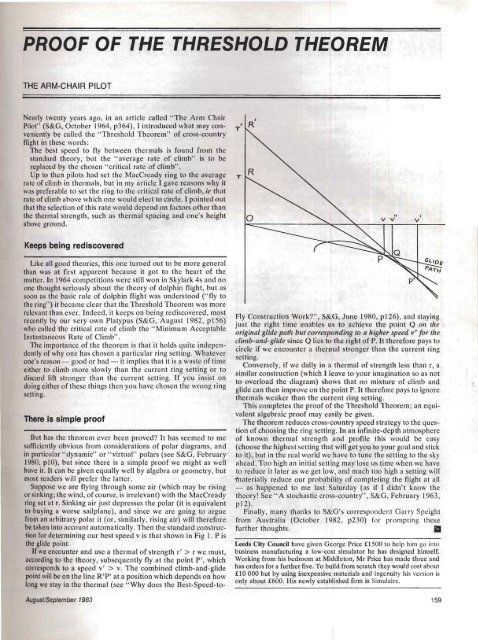Volume 34 No 4 Aug-Sept 1983.pdf - Lakes Gliding Club
Volume 34 No 4 Aug-Sept 1983.pdf - Lakes Gliding Club
Volume 34 No 4 Aug-Sept 1983.pdf - Lakes Gliding Club
- No tags were found...
Create successful ePaper yourself
Turn your PDF publications into a flip-book with our unique Google optimized e-Paper software.
PROOF OF THE THRESHOLD THEOREMTHE ARM-CHAIR PILOTNearly twenty years ago, in an article called "The Arm ChairPilot" (S&O, October 1964, p364), I introduced what may (;on- T( R'veniently be called the "Threshold Theorem" of cross-wuntryflight in these words:The best speed to fly between thermals is found from thestandard theory, but the "average rate of climb" is to bereplaced by the chosen "critical rate of climb".Up to then pilots had set the MacCready ring to the averageratc of climb in thermals, but in my article 1 gave reasons wby itwas preferable to set the ring to the critical rate of climb, ie thatrate of climb above which one would elect to circle. I pointed outthat the selection of this rate would depend on factors other thanthe thermal strength, such as thermal spacing and one's heightabove ground.Keeps being rediscoveredLike all good theories, this one turned out to be more generalthan was at first apparent because it got to the heart of thematter. In 1964 competitions were still won in Skylark 4s and noone thought seriously about the theory of dolphin flight, but assoon as the basic rule of dolphin flight was understood ("fly tothe ring") it became clear that the Threshold Theorem was morerelevant than ever. Indeed, it keeps on being rediscovered, mostrecently by our very own Platypus (S&G, <strong>Aug</strong>ust 1982, p 156)who called the critical rate of climb the" Minimum AcceptableInstantaneous Rate of Climb".The importance of the theorem is that it holds quite independentlyof why one has chosen a particular ring setting. Whateverone's reason - good or bad - it implies that it is a waste of timeeither to climb more slowly than the current ring setting or todiscard lift stronger than the current setting. If you insist ondoing either of these things then you have chosen the wrong ringsetting.There Is simple proofBut has the theorem ever been proved? It has seemed to mesufficienUy obvious from considerations of polar diagrams, andin particular "'dynamic" or "virtual" polars (see S&G, February1980, plO), but since there is a simple proof we might as wellhave it It can be given equally well by algebra or geometry, butmost readers will prefer the latter.Suppose we are flying through some air (which may be risingor sinking; the wind, of course, is irrelevant) with the MacCreadyring set at r. Sink,ing air just depresses the polar (it is equivalentto buying a worse sailplane), and since we are going to arguefrom an arbitrary polar it (or, similarly, rising air) will thereforebe taken into account automatically. Then the standard constructionfor determiFl ing our best speed v is that shown in Fig 1. P isthe glide point.If we encounter and use a thermal of strength r' > r we must,according to the theory, subsequently fly at the point P', whichcorresponds to a speed v' > v. The combined climb-and-glidepoint will be on the line R'P' at a position which depends on howlong we stay in the thermal (see "Why does the Best-Speed-to-Fly Construction Work?", S&G, June 1980, pI26), and stayingjust the l'ight time enables liS IQ achieve the point Q 0/1 rheoriginal glide pal" bUI corresponding 10 a higher speed v" for theclimb-and-glide since Q lies to the right of P. It therefore pays tocircle if we encounler a thermal stronger than the current ringsetting.Converse!.y, if we dally in a thermal of strength less than 1', asimilar cO[lstnlction (which I leave to your imagination so as notto overload the diagram) shows that no mixture of climb andglide can ,then improve on the point P. It therefore pays to ignorethermals weaker than the current ring seuing.This comp,letes the proof of the Threshold Theorem; an equivalentalgebraic proof may eas,ily be given.The theorem reduces cross-country speed strategy to the quest,ionof choosing the ring setting. In an infinite-depth atmosphereof known thermal strength and profile this would be easy(choose the highest setting that will get you 10 your goal and stickto it), but in the real world we have to tune the setting to the skyahead. Too high an initial setting may lose us time when we haveto reduce it later as we get low, and much too high a setting willmaterially reduce our probability of completing the flight at all- as happened to me last Saturday (as if I didn't know thetheory! See" A stochastic cross-country", S&G, February 1963,p 12).Finally, many thanks to S&G's correspondent Garry Speightfrom Australia (October 1982, p230) for prompting thesefurther thoughts.IIILeeds City Council have given George Price £1500 to help him go intobusiness manufacturing a low-cost simulator he has designed himself.Working from his bedroom at Middleton, Mr Plice has made three andhas orders for a further five. To build from scratch they would cost about£10 000 but by using inexpensive materials and ingenuity his version isonly about £600. His newly established firm is Simulaire.<strong>Aug</strong>ust/<strong>Sept</strong>ember 1983 159
















